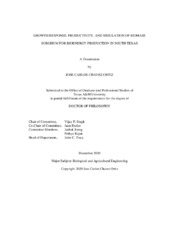| dc.description.abstract | Considerable research has been conducted to evaluate the productivity of biomass sorghum hybrids for bioenergy production, but research questions were mostly focused on determining the highest yielding hybrid for a single sowing season. Considering that a bioenergy refinery requires a sustained supply of biomass, this dissertation explores the production of several varieties for various sowing seasons, soil types, water supply condition, and irrigation methods to select the most profitable practices. Therefore, the main goal of this dissertation was to investigate and evaluate the effect of weather and management conditions on growth response and productivity of biomass sorghum for bioenergy production using replicated field experiments and computer simulation. It also studied the effect of crop parameters, such as radiation use efficiency (RUE) and water use efficiency (WUE) on crop growth of several sowing dates and varieties.
A variance analysis determined that significant differences (p < 0.05) were observed among sorghum hybrids and sowing seasons in dry biomass (DB) production, leaf area index (LAI), and WUE. The highest DB yields, LAI values, and WUE were observed on the energy hybrids sowed between March and May. Energy hybrids also exhibited higher maximum and average crop growth rate (CGR) in the early sowing seasons of the year. They also could produce up to 66% more biomass than forage hybrids, and they also had the potential for producing as much as 33 Mg ha-1 with an average of 530 mm of water using drip irrigation in south Texas when sown from March to May.
Successful calibration of the Environmental Policy Integrated Climate (EPIC) model allowed to conduct simulations to determine the total DB, LAI, crop water use (CWU), the relationship between crop productivity and crop evapotranspiration (ETc), and WUE of biomass sorghum. The most important crop parameters identified in EPIC that needed to be adjusted to achieve appropriate DB were the biomass energy-ratio (WA), potential heat units (PHU), and the Hargreaves-Samani PET equation coefficient (PARM 38), and exponent (PARM 13). The statistical parameters derived from measured versus simulated dry biomass in the calibrated model indicated that the EPIC model performed well, showing a great potential for simulating the total DB of sorghums. Thus, it was demonstrated that the EPIC model could be used for the assessment of crop water use and total DB production under limited irrigation levels, especially in semi-arid regions.
It was found that RUE depended on crop variety and sowing seasons. Higher RUE values were observed for the energy hybrids in the sowing dates from March to May. Therefore, the changing of these RUE values according to the sowing date can improve the prediction of DB in crop models. The EPIC model was parameterized using the RUE values from field experiments to enhance the effectiveness of the crop simulation model to predict the potential DB of biomass sorghum. The statistical parameters derived from measured versus simulated DB indicated that the EPIC model performed well at estimating DB with an average percent error of 11% at harvest, and an average R2 = 0.91. Therefore, the identification of adequate RUE values for different sowing seasons enhanced crop simulation effectiveness in predicting sorghum growth and yield response for staggered biomass production. | en |


